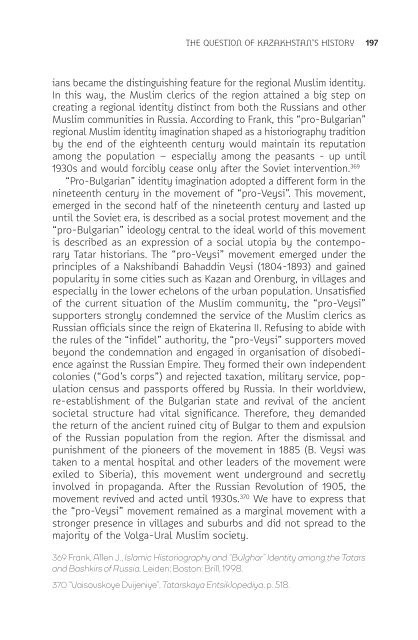THE SOVIET HISTORIOGRAPHY AND THE QUESTION OF KAZAKHSTAN’S HISTORY
SOVYET-TARIH-YAZICILIGI-ENG
SOVYET-TARIH-YAZICILIGI-ENG
You also want an ePaper? Increase the reach of your titles
YUMPU automatically turns print PDFs into web optimized ePapers that Google loves.
<strong>THE</strong> <strong>QUESTION</strong> <strong>OF</strong> <strong>KAZAKHSTAN’S</strong> <strong>HISTORY</strong> 197<br />
ians became the distinguishing feature for the regional Muslim identity.<br />
In this way, the Muslim clerics of the region attained a big step on<br />
creating a regional identity distinct from both the Russians and other<br />
Muslim communities in Russia. According to Frank, this “pro-Bulgarian”<br />
regional Muslim identity imagination shaped as a historiography tradition<br />
by the end of the eighteenth century would maintain its reputation<br />
among the population – especially among the peasants - up until<br />
1930s and would forcibly cease only after the Soviet intervention. 369<br />
“Pro-Bulgarian” identity imagination adopted a different form in the<br />
nineteenth century in the movement of “pro-Veysi”. This movement,<br />
emerged in the second half of the nineteenth century and lasted up<br />
until the Soviet era, is described as a social protest movement and the<br />
“pro-Bulgarian” ideology central to the ideal world of this movement<br />
is described as an expression of a social utopia by the contemporary<br />
Tatar historians. The “pro-Veysi” movement emerged under the<br />
principles of a Nakshibandi Bahaddin Veysi (1804-1893) and gained<br />
popularity in some cities such as Kazan and Orenburg, in villages and<br />
especially in the lower echelons of the urban population. Unsatisfied<br />
of the current situation of the Muslim community, the “pro-Veysi”<br />
supporters strongly condemned the service of the Muslim clerics as<br />
Russian officials since the reign of Ekaterina II. Refusing to abide with<br />
the rules of the “infidel” authority, the “pro-Veysi” supporters moved<br />
beyond the condemnation and engaged in organisation of disobedience<br />
against the Russian Empire. They formed their own independent<br />
colonies (“God’s corps”) and rejected taxation, military service, population<br />
census and passports offered by Russia. In their worldview,<br />
re-establishment of the Bulgarian state and revival of the ancient<br />
societal structure had vital significance. Therefore, they demanded<br />
the return of the ancient ruined city of Bulgar to them and expulsion<br />
of the Russian population from the region. After the dismissal and<br />
punishment of the pioneers of the movement in 1885 (B. Veysi was<br />
taken to a mental hospital and other leaders of the movement were<br />
exiled to Siberia), this movement went underground and secretly<br />
involved in propaganda. After the Russian Revolution of 1905, the<br />
movement revived and acted until 1930s. 370 We have to express that<br />
the “pro-Veysi” movement remained as a marginal movement with a<br />
stronger presence in villages and suburbs and did not spread to the<br />
majority of the Volga-Ural Muslim society.<br />
369 Frank, Allen J., Islamic Historiography and “Bulghar” Identity among the Tatars<br />
and Bashkirs of Russia, Leiden; Boston: Brill, 1998.<br />
370 “Vaisovskoye Dvijeniye”, Tatarskaya Entsiklopediya, p. 518.



